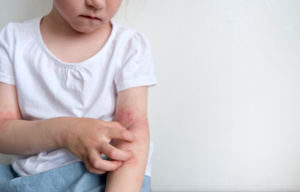Increased risk of atopic dermatitis caused by vitamin D deficiency in early childhood
 Atopic dermatitis is a common skin disease. Our modern lifestyle plays a role, and vitamin D deficiency in early childhood also seems to increase the risk of developing the disease later in life, according to a study that is published in World Allergy Organisation Journal. The health authorities recommend that pregnant women and small children take a vitamin D supplement.
Atopic dermatitis is a common skin disease. Our modern lifestyle plays a role, and vitamin D deficiency in early childhood also seems to increase the risk of developing the disease later in life, according to a study that is published in World Allergy Organisation Journal. The health authorities recommend that pregnant women and small children take a vitamin D supplement.
Atopic dermatitis used to be a relatively rare disease, but now it affects up to 20 percent of Danish children. In most cases, it occurs before they reach the age of five years. Around five to eight percent of adults are affected by the disease. Genes, environment, diet, sun exposure, and allergies play a role in the development of the disease.
In atopic dermatitis, the skin barrier is weakened, which causes impaired protection against allergy-inducing substances, bacteria, and other irritants. The immune system reacts by launching skin inflammation. This causes symptoms like dry, red, and itchy skin.
Allergic reactions to foods like cow’s milk, dairy products, and eggs usually show early in childhood and after breastfeeding has been discontinued. Allergic reactions to airborne allergens such as house dust and pollen usually surface in late childhood.
Numerous studies have shown an inverse relation between blood levels of vitamin D and the risk of specific allergic reactions involving IgE antibodies in early childhood. But there is a lack of information regarding the link between blood levels of vitamin D, allergen exposure, and the risk of developing atopic dermatitis during a child’s first years of life.
The new study included 222 children, who were divided into the following three groups:
- 95 children aged six months (59 with atopic dermatitis and 36 healthy controls)
- 66 children aged two years (37 with atopic dermatitis and 29 healthy controls)
- 61 children aged four years (32 with atopic dermatitis and 29 healthy controls)
Blood levels of vitamin D (as 25(OH)D) were measured in all children - and 75 nmol/L is considered sufficient, while less than 50 nmol/L is defined as a deficiency.
The researchers also used a test called ImmunoCap to evaluate total blood levels of IgE antibodies and specific IgE antibodies against allergens found in the air and in food. The researchers wanted to study the closer relation between blood levels of vitamin D, allergen exposure, and the impact on the development of atopic dermatitis in different age groups.
Their study showed the following:
- Children aged two to four years with atopic dermatitis had significantly lower levels of vitamin D in their blood compared with the healthy controls
- Children in all age groups who lacked vitamin D had higher levels of several IgE antibodies (and therefore greater sensitivity) than the healthy controls
- Blood levels of vitamin D were inversely related to allergic reactions
- Blood levels of vitamin D are very important for allergen effects in all ages, and influence the risk of developing atopic dermatitis in the age group two to four years.
- Based on their study, the researchers conclude that there is an inverse relation between vitamin D levels and the rate of atopic dermatitis in early childhood years.
Important: Year-round vitamin D supplementation of pregnant women and small children prevents atopic dermatitis
The Danish health authorities recommend that pregnant women take 10 micrograms of vitamin D daily to support the baby’s growth and bone development. This recommendation, however, does not focus on the baby’s immune defense and all the other vitamin D-dependent body functions.
A previous study that is published in British Journal of Dermatology showed that daily supplementation with 25 micrograms of vitamin D during pregnancy lowers the risk of atopic dermatitis in children during their first years of life. However, high-dosed vitamin D supplementation during pregnancy did not have any preventative effect on atopic dermatitis in children older than two years of age. For that reason, all children should also take vitamin D to obtain a continued positive effect on their skin and other functions.
The Danish Health Authority recommends daily supplementation with 10 micrograms of vitamin D all year round for all children up to the age of four years and all children with dark skin. It is also good for the children to get exposed to the sun during the summer, as long as they avoid getting sunburns. After all, the sun is our primary source of vitamin D.
According to the health authorities, the safe upper intake level for vitamin D supplementation is:
- 25 micrograms for babies
- 50 micrograms for children aged one to 10 years
- 100 micrograms for older children and adults, including pregnant and breastfeeding women
References:
Chin-Hsuan Shen et al. Vitamin D level is inversely related to allergen sensitization for risking atopic dermatitis in early childhood. World Allergy Organisation Journal 2024
Sarah El-Heis et al. Maternal antenatal vitamin D supplementation and offspring risk of atopic eczema in the first 4 years of life: evidence from a randomised controlled trial. British Journal of Dermatology. 2022
University of Southampton. Taking Vitamin D during pregnancy could lower the risk of eczema in babies. ScienceDaily. July 5, 2022
TIP! See also the related articles
Search for more information...
- Created on .








